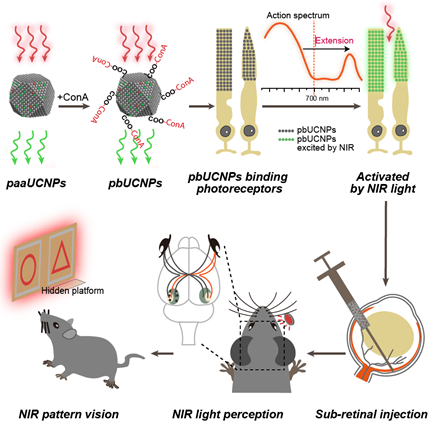
Mammalian Near-Infrared Image Vision through Injectable and Self-Powered Retinal Nanoantennae
Yuqian Ma, Jin Bao, Yuanwei Zhang, Zhanjun Li, Xiangyu Zhou, Changlin Wan, Ling Huang, Yang Zhao, Gang Han, Tian Xue
Summary
Mammals cannot see light over 700 nm in wavelength. This limitation is due to the physical thermodynamic properties of the photon-detecting opsins. However, the detection of naturally invisible near-infrared (NIR) light is a desirable ability. To break this limitation, we developed ocular injectable photoreceptor-binding upconversion nanoparticles (pbUCNPs). These nanoparticles anchored on retinal photoreceptors as miniature NIR light transducers to create NIR light image vision with negligible side effects. Based on single photoreceptor recordings, electroretinograms, cortical recordings, and visual behavioral tests, we demonstrated that mice with these nanoantennae could not only perceive NIR light but also see NIR light patterns. Excitingly, the injected mice were also able to differentiate sophisticated NIR shape patterns. Moreover, the NIR light pattern vision was ambient daylight compatible and existed in parallel with native daylight vision. This new method will provide unmatched opportunities for a wide variety of emerging bio-integrated nanodevice designs and applications.
This work has been accepted by Cell and was selected as Cell Best of 2019, Cell press (9 Best Articles which published in Cell in 2019).







